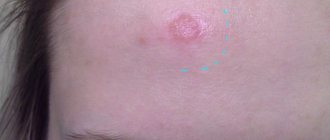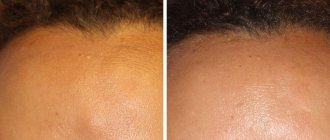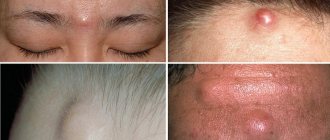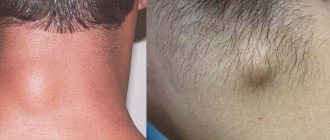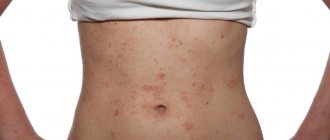Review
Various formations under the skin: bumps, balls, compactions, tumors - this is a common problem that almost every person faces.
In most cases, these formations are harmless, but some of them require emergency treatment. Lumps and lumps under the skin can develop on any part of the body: face, arms and legs, back, abdomen, etc. Sometimes these formations are hidden in the folds of the skin, on the scalp, or grow so slowly that they remain unnoticed for a long time and are discovered reaching large sizes. Benign neoplasms of the skin and soft tissues usually proceed asymptomatically.
Lumps or lumps that cause pain or discomfort are often the result of infection. They may be accompanied by an increase in general or local temperature. The skin over them usually turns red. Associated disorders occur: general malaise, headache, weakness, etc. With timely treatment, such formations usually go away quickly.
Much less common are malignant neoplasms of the skin and underlying tissues, which can be palpated or noticed on your own. You need to be able to recognize these diseases in time and consult a doctor as soon as possible. Below we outline the most common skin lesions that may cause concern.
Lump on back between shoulder blades
A lump on the back under the skin between the shoulder blades is formed when the spine is curvature due to the displacement of sebaceous accumulations. Usually an atheroma forms there. It does not bring discomfort, there is no pain. It happens that such phenomena form cysts, which also need to be removed. It is located on the back under the skin below the shoulder blade. There is no pain, and it also does not cause any discomfort.
Such irregularities must be shown to a specialist, because any foreign body must be examined by a doctor to identify the causes of its appearance and harm. It is worth remembering: even the smallest tumor can eventually transform into a malignant tumor.
Lipoma (wen)
Lumps under the skin most often turn out to be lipomas. These are benign, completely safe tumors from fat cells. Lipoma can be felt under the skin as a soft formation with clear boundaries, sometimes with a bumpy surface. The skin over the lipoma is of normal color and density, easily folded.
Most often, lipomas appear on the scalp, neck, armpits, chest, back and thighs. When they reach large sizes, they can cause pain by squeezing neighboring organs or muscles. Find out more about how to get rid of lipoma.
How to get rid of wen on the face?
There are several methods to help get rid of such formations on the face. The destruction of fatty tissues should not end with the appearance of scars; the procedure must be painless and safe.
Basic methods:
- Use of medications.
In the presence of small wen, a dermatologist can prescribe drugs that soften the tissue of the epidermis, disinfect the cavity of the wen and promote its resorption. These are Vitaon ointment, Vishnevsky ointment, ichthyol ointment and other means that pull out deep formations from under the skin. Medicines are applied to the skin pointwise, in the projection of the wen.
- Injection lipolysis.
The doctor can remove a small wen by injecting it with a special substance that dissolves deposits of lipid cells. After 2-3 months, the formation completely disappears. The method has a drawback - it is ineffective in 20% of cases.
- Surgery to remove a wen.
It is used for impressively sized lesions (more than 2 cm in diameter). During the manipulation, the top layer of skin is cut, the capsule is emptied and peeled. After surgical removal of a wen, a noticeable scar may remain on the face, so the method is not popular. Most patients prefer to pay extra and get rid of the defect using a laser or radio wave knife in a private clinic, but this is not always possible.
The duration of a traditional surgical operation is 20-30 minutes, during which the capsule and the fat accumulated in it are removed. If the wen was of impressive size and inflamed, drainage is first installed in the wound. Only after the purulent process has stopped is the capsule removed and sutures placed.
Removal of a non-inflamed wen on the face can be done by liposuction, when the contents of the formation are pumped out using a special syringe. The advantages of the procedure include speed, low trauma and the absence of a scar. But there is also a serious drawback - since the capsule remains in place, there is a high risk of relapse.
Atheroma
Atheroma is often confused with lipoma, also called a wen. In fact, it is a cyst, that is, a stretched sebaceous gland in which the excretory duct is blocked. The contents of the atheroma, sebum, gradually accumulates, stretching the capsule of the gland.
To the touch it is a dense, round formation with clear boundaries. The skin over the atheroma cannot be folded; sometimes the surface of the skin takes on a bluish color and you can see a point on it - a blocked duct. Atheroma can become inflamed and fester. If necessary, it can be removed by a surgeon.
Nodules on the joints
Various joint diseases: arthritis and arthrosis are often accompanied by the appearance of small, hard, immobile nodules under the skin. Such formations in the elbow joint are called rheumatoid nodules and are characteristic of rheumatoid arthritis. Nodules on the extensor surface of the joints of the fingers - Heberden's and Bouchard's nodes accompany deforming osteoarthritis.
Gouty nodes - tophi, which are accumulations of uric acid salts and grow on the joints of people who have suffered from gout for many years, can reach a significant size.
A subcutaneous lump on the foot deserves special attention - a hard growth of the joint of the big toe, which is accompanied by valgus deformity - curvature of the toe. The bunion on the foot gradually grows, interferes with walking and creates difficulties in choosing shoes. Learn about the treatment of hallux valgus.
Hernia
It feels like a soft protrusion under the skin, which can appear during exercise and disappear completely when lying down or at rest. A hernia forms in the navel, postoperative scar on the abdomen, in the groin, on the inner surface of the thigh. The hernia may be painful when palpated. Sometimes you can push it back in with your fingers.
A hernia is formed by the internal organs of the abdomen, which are squeezed out through weak spots in the abdominal wall during an increase in intra-abdominal pressure: when coughing, lifting heavy objects, etc. Find out whether a hernia can be cured using traditional methods, and why it is dangerous.
Hard balls under the skin due to ingrown hairs
Under certain conditions, not all of the hair is shaved off; part of it remains under the skin and cannot break through, so it bends and grows inside the hair follicle. This is how ingrown hairs appear, they cause inflammation, pain and form small hard balls in the shaving area. Most often this is the chin, back of the head, armpits and pubic area. Sometimes an ingrown hair can become an enlarged lump (cyst) after infection.
Ingrown hairs
Anyone who shaves, uses tweezers or waxes for hair removal can experience similar problems. Such “bumps” often go away on their own, but they can also sometimes be helped when the hair is very close to the surface.
Enlarged lymph nodes (lymphadenopathy)
Most often accompanied by colds. Lymph nodes are small round formations that can be felt under the skin in the form of soft elastic balls the size of a pea to a plum, not fused to the surface of the skin.
Lymph nodes are located in groups in the neck, under the lower jaw, above and below the collarbones, in the armpits, in the elbows and knees, in the groin and other parts of the body. These are components of the immune system that, like a filter, pass interstitial fluid through themselves, clearing it of infection, foreign inclusions and damaged cells, including tumor cells.
An increase in the size of the lymph nodes (lymphadenopathy), which become painful when palpated, usually accompanies infectious diseases: sore throat, otitis media, flux, panaritium, as well as wounds and burns. Treatment of the underlying disease leads to a reduction in the node.
If the skin over the lymph node turns red, and palpation becomes sharply painful, the development of lymphadenitis is likely - a purulent lesion of the node itself. In this case, you need to contact a surgeon. Minor surgery may be required, and early treatment can sometimes clear up the infection with antibiotics.
If a dense, tuberous formation is felt under the skin, and the skin above it cannot be folded, the node is likely damaged by a malignant tumor. In this case, consult an oncologist as soon as possible. Read more about other causes of swollen lymph nodes.
How to treat lumps under the skin quickly and effectively
Many people wonder whether it is possible to treat lumps under the skin at home? The answer is clear: under no circumstances should you try to squeeze out, puncture, or influence it by any mechanical means. If you find a defect, contact a specialist. First, visit a therapist, and only after that a specialist: oncologist, surgeon or dermatologist.
Some lumps go away on their own and do not require treatment. For example, lipomas are removed when they become a visible cosmetic defect, and the doctor may even recommend not touching a small cyst if it does not cause discomfort. If the cyst becomes inflamed, then special injections or surgery are prescribed. Fibroma and hygroma are removed surgically. If the lump is associated with an infectious disease, then first you should undergo a course of treatment aimed at eliminating the problem.
If you find a lump under the skin, be sure to consult a specialist. Only he will be able to finally exclude or confirm your concerns, explain why the ball has formed under the skin, and prescribe the correct treatment.
A small ball under the skin on the leg is not just a cosmetic defect. Even if there is no pain, itching or discomfort, it can be a sign of a serious illness. To determine the cause of a neoplasm, you need to pay attention to its location and accompanying symptoms.
Warts, papillomas, condylomas, soft fibromas
All these terms refer to small growths on the skin of various shapes: in the form of a polyp, a mole on a thin stalk, growths in the shape of a cockscomb or cauliflower, a hard nodule or papilla protruding above the surface. These lesions may be yellowish, pale, brown, or flesh-colored and have a smooth or flaky surface. Read more and look at photos of warts and papillomas.
Their causes are different: most often it is a viral infection, mechanical injury, hormonal disorders. Sometimes warts and papillomas grow “out of the blue,” for no apparent reason, and can be located on any part of the body, including the mucous membranes of the genital organs. For the most part, these are harmless growths that cause only cosmetic discomfort or interfere with wearing clothes or underwear. However, the variety of their shapes, colors and sizes does not allow one to independently distinguish a benign wart, condyloma or soft fibroma from malignant skin diseases. Therefore, if a suspicious growth appears on the skin, it is advisable to show it to a dermatologist or oncologist.
Lump under the skin after vaccination
Vaccination is a reliable way to protect against infections without causing serious side effects. But some children experience various symptoms after vaccinations, such as:
- fever within 2-3 days after vaccination;
- redness at the injection site;
- a dense area at the injection site (in this case, a cold compress will help);
- a rash in the form of red dots may cover the child from head to toe, but it is harmless and will go away within a week;
- in rare cases, the entire vaccination area may become red, swollen, and hot (pain reliever and hydrocortisone ointment will help).
Lump in the breast (in the mammary gland)
Almost every woman experiences breast lumps at various times in her life. In the second phase of the cycle, especially on the eve of menstruation, small lumps may be felt in the breasts. Usually, with the onset of menstruation, these formations disappear and they are associated with normal changes in the mammary glands under the influence of hormones.
If hardening or peas in the breast are palpable and after menstruation, it is advisable to contact a gynecologist who will examine the mammary glands and, if necessary, prescribe additional examination. In most cases, breast formations turn out to be benign; some of them are recommended to be removed, while others can be treated conservatively.
Reasons to urgently consult a doctor are:
- rapid increase in the size of the node;
- pain in the mammary glands, regardless of the phase of the cycle;
- the formation does not have clear boundaries or the contours are uneven;
- over the node there is retracted or deformed skin, an ulcer;
- there is discharge from the nipple;
- Enlarged lymph nodes can be felt in the armpits.
If these symptoms are detected, it is advisable to immediately contact a mammologist or, if such a specialist could not be found, an oncologist. Read more about the types of breast lumps and their treatment.
Skin inflammation and ulcers
A whole group of skin lesions may be associated with infection. The most common cause of inflammation and suppuration is the bacterium staphylococcus. The skin in the affected area turns red, swelling and induration of varying sizes appear. The surface of the skin becomes hot and painful to the touch, and overall body temperature may also increase.
Sometimes inflammation quickly spreads across the skin, covering large areas. Such a diffuse lesion is characteristic of erysipelas (erysipelas). A more serious condition - phlegmon - is a purulent inflammation of the subcutaneous fatty tissue. Focal inflammatory diseases are common: carbuncle and furuncle, which are formed when hair follicles and sebaceous glands are damaged.
Surgeons treat purulent-inflammatory diseases of the skin and soft tissues. If redness, pain and swelling appear on the skin, accompanied by an increase in temperature, you should seek help as soon as possible. In the initial stages, the problem can be solved with the help of antibiotics; in more advanced cases, surgery must be resorted to.
Treatment
Conservative or surgical methods are used to treat subcutaneous lumps. The determining factors are the size of the compaction and the reason for its development. If the formation is benign, small in size and does not cause any physical or emotional discomfort, then you can only observe it. If the lump grows, symptoms of inflammation and other signs of activity, measures are taken to eliminate the problem area.
Conservative therapy is used only if there is a possibility that the lump may disappear over time. To do this, antibiotics or antivirals are selected, external agents are prescribed, the action of which is aimed at the problem area. If necessary, antihistamines, antiallergic drugs, and hormonal drugs are taken.
Remember! In some cases, surgical intervention is advisable. It can be done using a puncture, using a laser, or by opening, excision, or drainage.
For each patient, depending on the clinical picture, an individual treatment regimen and surgical options are determined.
Malignant tumors
Compared to other skin lesions, malignant tumors are very rare. As a rule, at first a focus of compaction or a nodule appears in the thickness of the skin, which gradually grows. Usually the tumor does not hurt or itch. The surface of the skin may be normal, flaky, crusty, or dark in color.
Signs of malignancy are:
- uneven and unclear boundaries of the tumor;
- enlargement of nearby lymph nodes;
- rapid growth in education;
- adhesion to the surface of the skin, inactivity when palpating;
- bleeding and ulceration on the surface of the lesion.
A tumor can develop at the site of a mole, like melanoma. It can be located under the skin, like a sarcoma, or at the site of a lymph node - lymphoma. If you suspect a malignant skin tumor, you should contact an oncologist as soon as possible.
Why did a lump appear under the skin: the main reasons
The most common diseases that are accompanied by subcutaneous lumps are:
1. Lipoma. The tumor is formed from adipose tissue. The lump is painless, has the same color as the skin, and when touched, a dense formation is felt. As a rule, a lipoma is a benign tumor and does not cause discomfort. Such tumors occur due to metabolic disorders in the body. Statistics show that women are more susceptible to this disease than the stronger sex.
2. Subcutaneous cyst. The symptoms of a cyst are the same as for a lipoma, the difference is periodic inflammation of the lump. In some cases, contents are released from the cone.
3. Hygroma. This compaction in the form of a ball under the skin does not cause virtually any discomfort, except for a visible cosmetic defect. Most often, a lump occurs on the hand under the skin on the wrist or palm. It is an accumulation of liquid and can burst on its own under any mechanical stress.
4. Fibroma. A benign tumor that does not hurt, does not itch, and does not protrude much above the surface of the skin. Fibroma occurs after injuries, inflammatory processes, and may be associated with a hereditary factor. The lump can be soft or hard, and the color of the lump varies from brown to red.
Which doctor should I contact with a lump or lump on the skin?
If you are concerned about formations on your body, find a good doctor using the NaPravku service:
- a dermatologist - if the lump looks like a wart or papilloma;
- surgeon - if surgical treatment of an abscess or benign tumor is required;
- oncologist to rule out a tumor.
If you think that another specialist is needed, use our help section “Who Treats It”. There, based on your symptoms, you can more accurately decide on the choice of a doctor. You can also start with an initial diagnosis from a therapist.
You might also be interested in reading
Localization and translation prepared by Napopravku.ru. NHS Choices provided the original content for free. It is available from www.nhs.uk. NHS Choices has not reviewed, and takes no responsibility for, the localization or translation of its original content
Copyright notice: “Department of Health original content © 2019”
All site materials have been checked by doctors. However, even the most reliable article does not allow us to take into account all the features of the disease in a particular person. Therefore, the information posted on our website cannot replace a visit to the doctor, but only complements it. The articles have been prepared for informational purposes and are advisory in nature.
My husband has some hard formations under his skin all over his body, like lumps several centimeters in diameter. On the arms, back, chest, etc. They don’t hurt, they don’t show themselves in any way. He says he has had this since he was young. simple now there are a little more of them. What could it be? Maybe these are wen? (I've heard about them, but I don't know how it manifests itself). Has anyone encountered anything like this?
Woman.ru experts
Find out the opinion of an expert on your topic
Kostenich Lyudmila Stanislavovna
Psychologist, Art therapist. Specialist from the site b17.ru
Marina Aleksandrovna Baydyuk
Psychologist, Analytical psychologist. Specialist from the site b17.ru
Valeria Bertnik-Yuryeva
Psychologist, Psychologist-guide. Specialist from the site b17.ru
Pukemova Olga
Psychologist. Specialist from the site b17.ru
Nevzorova Sofya Igorevna
Psychologist. Specialist from the site b17.ru
Alina Sysoeva
Psychologist, Coach and Trainer. Specialist from the site b17.ru
Juran Marina Vladimirovna
Psychologist, Family child psychologist. Specialist from the site b17.ru
Ekaterina Alekseevna Vasyukhina
Psychologist, Crisis counseling. Specialist from the site b17.ru
Spiridonova Nadezhda Viktorovna
Psychologist. Specialist from the site b17.ru
